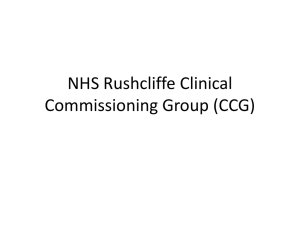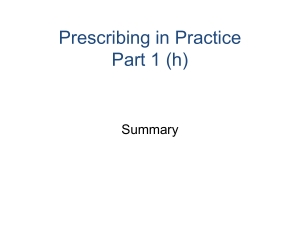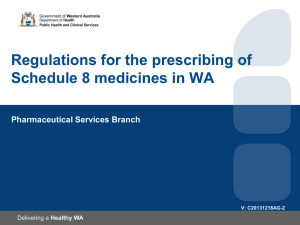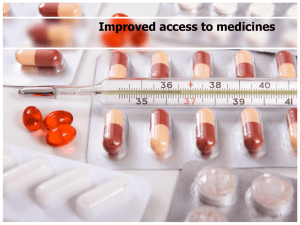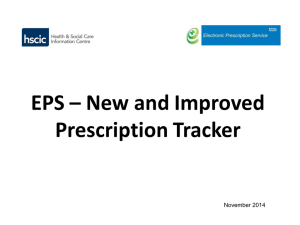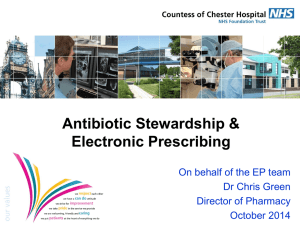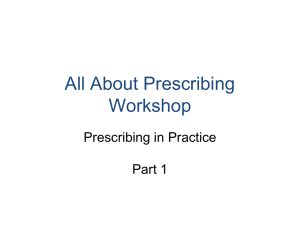About Prescriptions Workshop - Prescribing in Practice
advertisement
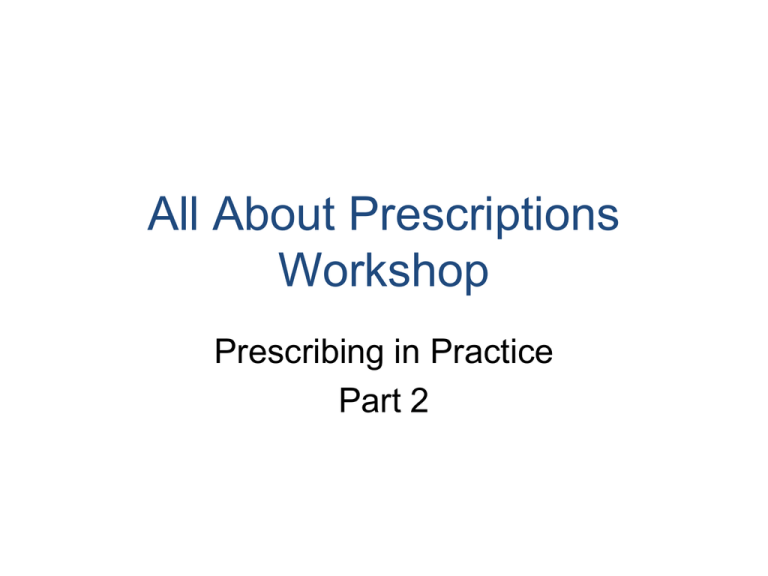
All About Prescriptions Workshop Prescribing in Practice Part 2 Aims and Objectives To inform non medical prescribers about:• Types of prescribing in Hospitals • Prescriptions for non-NHS and AHPs • Potential areas for error in prescription writing At the end of the session students will understand all the above issues and have had practical experience of writing prescriptions using their BNF. Hopital Based Nurses Hospital based nurses may use one of three methods to prescribe: • 1) Ward order- to be used for inpatients and discharge supplies only. A prescription charge is not levied on inpatients. Hospital Nurses (cont.) • 2) Internal hospital prescription formTO BE USED FOR OUTPATIENTS – but only in cases where the hospital pharmacy will dispense the prescription. A prescription charge may be payable, unless the patient is exempt from prescription charges. For this reason these types of form often resemble an FP10 Hospital Nurses Continued (cont.) • 3) FP10HP prescription form – to be used where the prescription will be dispensed by a community pharmacist. • Managers of hospital based nurses should order FP10HP which will be supplied ready for hand stamping with nurse and hospital details: Non Medical PRESCRIBER NMC No. or other registration number Non NHS Nurses & AHPs • A Non NHS Nurse Prescriber cannot issue a FP10 type out-patient prescription, unless the organisation they work for has an arrangement with the NHS provider (e.g. Primary Care Trust) • AHPs: A mechanism is in place for the Health Professions Council to record the supplementary prescribing qualification after AHPs have qualified as prescribers. Who knows What the new system will be in primary care Changes of NMP details • Employers will need to keep a database of Nurse Prescriber details and inform the NHSBSA of changes as soon as possible. At least five days is needed between changes of details and re-ordering of prescription pads. • Hospital based nurses will not need to do this but if names or numbers are changed then hand stamps will need to be changed accordingly. How to write a prescription • Any IP must only prescribe drugs they are legally allowed to prescribe, some CDs are still not allowed, although legislation is due to change to cover all CDs. • Dispensers are not legally allowed to dispense any other items • If other items are dispensed the NHSBSA will not reimburse the pharmacist Challenges & opportunities • What issues can you envisage in your practice area? • How will you feel if you are asked to sign repeat prescriptions? • What challenges do the AHPs envisage? • Chadwick et al (2007) undertook an audit in NWSHA of practice – one of the authors works in a diabetic foot team with an IP Tissue Viability Nurse-potential to reduce hospital admissions and reduce amputations. Opportunities for … • Medication review • Review care plan • To ensure all the information was obtained by the first assessor, if you are following up • Referral on • Compliance • Reflection “Barometer," © 2005 Matt Wharton, Found at: http://www.flickr.com/photos/electricinca/5176578/. Used under a Creative Commons Attribution-ShareAlike 2.0 Generic license: http://creativecommons.org/licenses/bysa/2.0/deed.en_GB Writing prescriptions • NMPs are expected to prescribe in accordance with the information within the B.N.F., which forms the basis of their educational preparation, and is the basis on which their employers have agreed to include prescribing in the responsibilities of the post, make sure your job description reflects this role when you obtain your prescribing qualification. Potential areas for error when writing a prescription • Name of Prescribed Item – in full without abbreviations only using approved titles • Formulation • Strength (if any) • Dosage • Avoid unnecessary use of decimal points e.g. 5mgs not 5.0mg. If unavoidable a zero in front of the decimal point e.g. write 0.5ml not .5ml. Acceptable to use decimal point to express a range e.g. 0.5-1 g • Frequency • Quantity or duration of treatment Grams, milligrams and micrograms • Quantities of 1 gram or more should be written in grams e.g. write 2 g • Quantities less than 1 gram should be written in milligrams e.g. write 500mg not 0.5g • Quantities less than 1 mg should be written in micrograms e.g. write 100 micrograms and not 0.1 mg • Micrograms and Nanograms should not be abbreviated, the word Units should not be abbreviated • Calculations should be double checked • The Prescriber should re read the prescription once it is written Hospital Prescribing • • • • • • Name of the prescribed item Formulation Strength (if any) Dosage Frequency Where a defined length of treatment is required this should be stated. • For out-patients and discharge patients the requirements are the same as for community nurses Names of Medicines • Written clearly using approved generic titles (where available) as specified throughout the NPF/BNF, and should not be abbreviated. • The only exception to this rule is for the prescribing of some dressings and appliances, and of compound or modified release medicines which have no proprietary name. Directions • Directions should be in English and not abbreviated. • Where there is more than one item on a form a line should be inserted between each item for clarity. • Unused space should be blocked out with, for example a diagonal line (to prevent the fraudulent entry of other items) Prescriber’s signature and date • Legal responsibility lies with the Doctor or Nurse who signs the prescription. • Additional items prescribed by a doctor must be prescribed on a Doctor’s prescription and not added to an NMP’s prescription even if countersigned by a doctor. Serial Numbers • Should be recorded by the employer before issue to the nurse. • Recorded by the nurse to aid identification in the case of theft. • Blank prescriptions should NEVER be presigned. Nurses leaving their posts • It is the employers responsibility to retrieve unused prescription pads from nurses who are leaving or retiring. These should be shredded after recording serial numbers. Licensing of drugs • Previously known as Product licence nowMarketing Authorisations • Before a new product can be marketed the company has to produce evidence of safety and efficacy’. • The licence also restricts availability by defining the legal category of the drug. • All proprietary medicines will therefore bear a Marketing Authorisation number and a legal status code. Legal categories of Medicines • Prescription Only Medicines – POMs • No person may administer a POM to another person (except to himself) unless he is acting in accordance with the directions of an appropriate practitioner. This is with the exception of medical emergencies for the purpose of saving life in an emergency and applies to certain medicines e.g. epinepherine • Doctors can administer POMs without a prescription though it is good practice to keep adequate records. • NMPs should avoid administration of a POM without a prescription or PGD. Legal categories of Medicines (cont.) • General Sale List Medicines. (GSL) Can be sold in supermarkets, garages etc. Legal categories of Medicines (cont.) • Pharmacy Medicines (P medicines) • Can be bought in a pharmacy providing that the pharmacist is there to supervise the sale. • Pharmacists have a legal obligation to refuse the sale if they feel that the sale would compromise safety or contribute to abuse. • P medicine legislation is likely to change in 2012 so watch out for this Hospitals and the Medicines Act • All medicines provided to in patients are “de facto POM’s” this is because hospital pharmacies cannot sell medicines and supply is regulated through hospital policies. Label 30 • Do not take with any other paracetamol products To be used on all containers of dispensed preparations containing paracetamol • BNF 60(2010) Cautionary Labels • Can be used to give more detail that you feel strongly should be on the packaging of the product • A prescriber may feel on a specific occasion that a cautionary label should not be used- can you think of one that may be put on by the pharmacist? If you do not want the label to be used you must endorse your prescription with-’NCL’ but then the exact wording you want to replace this has to be specified Source BNF60 2010 Group Activity • In interprofessional groups you will complete an activity reviewing 3 written prescriptions • You will then develop a poster which promotes principles for safe prescription writing practice Further reading • Dean B. Barber N. Schachter M (2000) What is a prescribing error? Quality Health Care 9 pp232-237 • Reddy B. (2006) Prescription writing standards: why they are important Nurse Prescribing vol.4 No.8 pp330-335 • Maintaining competency in prescribing: An outline framework to help allied health professional supplementary prescribers • National Prescribing Centre (2004) Maintaining competency in prescribing: An outline framework to help allied health professional supplementary prescribers. Available on line @ http://www.npc.co.uk/maintain_comp_in_prescribing.htm • Prescribing Self Tests online: http://learning.north.londonmet.ac.uk/prescribing/prescribing_exe rcises.htm References British National Formulary www.bnf.org.uk Chadwick P, Stuart L, Fox M, Walley A, Morris L, Ashton-Mort ,S and McLennon, J ( 20070 An audit to improve the care of the diabetic foot Wounds UK vol. 3, no.2 pp73-77 This work was produced as part of the TIGER project and funded by JISC and the HEA in 2011. For further information see: http://www.northampton.ac.uk/tiger. This work by TIGER Project is licensed under a Creative Commons Attribution-NonCommercial-ShareAlike 3.0 Unported License. Based on a work at tiger.library.dmu.ac.uk. The TIGER project has sought to ensure content of the materials comply with a CC BY NC SA licence. Some material links to third party sites and may use a different licence, please check before using. The TIGER project nor any of its partners endorse these sites and cannot be held responsible for their content. Any logos or trademarks in the resource are exclusive property of their owners and their appearance is not an endorsement by the TIGER project.
